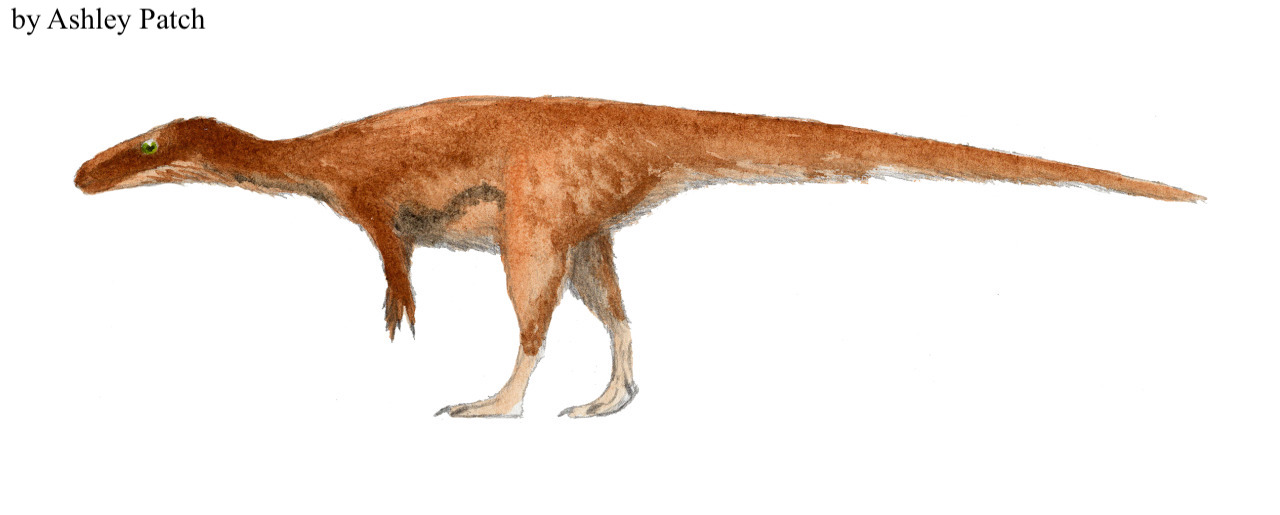Welcome to Alwalkeria

Name Definition
for Alick Walker (in honor of British paleontologist Alick Walker)
Name Given By
Sankar Chatterjee and Ben Creisler in 1994
Location
Maleri Formation in Andhra Pradesh, India
Classification
Dinosauria, Saurischia, ?Theropoda/Sauropodomorpha
Size
estimated to be about 0.4 meters tall (1.3 ft), about 0.5 - 1.5 meters long (1.6 - 4.9 ft), ~2 kg (4.4 lbs)
Temporal Range
Carnian stage of the late Triassic period, ~228 million years ago
Ecological niche
small omnivore
Species/Sub Species
A. maleriensis
Diet
based on the heterodont dentition that seemed neither carnivorous or herbivorous, scientists concluded that Alwalkeria was an omnivore and hunted small vertebrates and insects, but it would have also consumed plant material
Introduction
Alwalkeria is a genus of basal saurischian dinosaurs that lived in India during the late Triassic. Originally named Walkeria maleriensis (still named after Alick Walker) by Sankar Chatterjee in 1987, the name had to be changed since the genus name Walkeria was preoccupied by a genus of bryozoan (Bryozoa is a phylum of primitive, aquatic invertebrates). The name for the dinosaur needed a revision since a name is only given to the first genus that receives it, so Chatterjee and Ben Creisler changed the name in 1994, hence Alwalkeria. Alwalkeria honors British paleontologist Alick Walker, while the specific name, maleriensis, refers to the geological formation it was discovered in, the Maleri Formation.
Unfortunately, due to the fragmentary nature of the remains, not much about Alwalkeria’s anatomy is known, so we can only make guesses. The holotype consists of portions of the front ends of each jaw, 28 partial vertebrae from the spinal column, a majority of a femur (thigh bone), and an astragalus (ankle bone). From the partial skull, scientists estimated the skull to be about 4 cm long. The shape and the distances between the teeth in the premaxilla and maxilla are similar to those of Eoraptor, and Eoraptor has a gap that separates the teeth in the front portion of the upper jaw. There are also some other similarities between the two saurischians in the skull that connect them in morphology. Given the partial remains, the biggest estimate of Alwalkeria’s size was around 1.5 meters long. Alwalkeria has been confirmed to be a basal saurischian, though there is not enough fossil evidence to support whether it was a theropod or a sauropodomorph, however, given its similarities to Eoraptor which has been considered an ancestor of the sauropods, there is a possibility that Alwalkeria was also a sauropodomorph.
Like most of the guesses about the anatomy of Alwalkeria, its diet is also controversial. While it is unusual in reptiles, Alwalkeria has heterodont dentitions, which means that its teeth have different shapes based on their position in the mouth, similar to mammals. Seen in Eoraptor and other basal sauropodomorphs, Alwalkeria’s teeth in the front are slender and straight, but the teeth on the sides are curved backwards which are common in carnivorous theropods, though none of these teeth are serrated. The arrangement of these teeth are neither herbivorous or carnivorous, which suggests that it was most likely an omnivore and fed on plants as well as small invertebrates and vertebrates. Again, this most likely suggests that Alwalkeria was a sauropodomorph since Eoraptor is also known to be an omnivorous animal, though it is still entirely possible that Alwalkeria was a basal theropod.
The Maleri Formation is interpreted to be a site for a prehistoric lake or river system. This would have supported a wide variety of prehistoric life and vegetation, making a stable ecosystem. There have been a couple of prehistoric genera discovered from the formation including the prosauropods Jaklapallisaurus, Nambalia, and some indeterminate prosauropod remains from the Lower Maleri Formation. There are also some non-dinosaurian animals that have been discovered including the cynodont Exaeretodon, the rhynchosaur Hyperodapedon, the phytosaur Parasuchus, and the archosauromorph Malerisaurus.